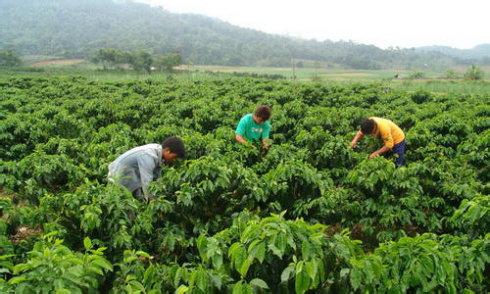Description of Coffee Flavor in Sidamo Coffee introduction to the characteristics of taste treatment in G1G2 Manor
Description of Coffee Flavor in Sidamo Coffee introduction to the characteristics of taste treatment in G1G2 Manor
The coffee in Sidamo has a variety of flavors. Different soil types, microclimates and countless native coffee species, towering mountains, highlands, plateaus, valleys and plains, diverse topography, and the geology of the area belongs to nutrient-rich, well-drained volcanic soil. the depth of the soil is nearly two meters, and the surface soil is dark brown or brown. The biggest advantage of the area is that the soil fertility is maintained through the circulation of organic matter, using the withered leaves of the surrounding trees or the residual roots of the plants as fertilizer. Therefore, the coffee produced in cities and towns has obvious differences and characteristics. In 2010-2012, it continuously obtained the high score of CR92~94, the authoritative coffee evaluation website in the United States. Thus it can be seen that the raw beans in this area are extraordinary.
Sidamo Coffee beans are grayish, thick in some places and small in others, with soft and strong acidity, mellow and sweet and spicy. It is one of the courtyard coffees in the highlands of southern Ethiopia. Unlike ordinary African coffee, Sidamo has clear acidity, smooth taste and delicate floral smell.
(1) Blue Mountain Coffee: from Jamaica. Pure Jamaican Blue Mountain Coffee perfectly combines the unique sour, bitter, sweet and mellow flavors of coffee. The aroma is very rich, mellow and smooth, with long-lasting fruit flavor, forming a strong and attractive elegance, which is unmatched by other coffee. It can be said to be the best coffee.
(2) Manning Coffee: produced in Indonesia's Sumatra Islands, full of grains, with a very strong flavor, spicy bitterness, people who especially like it will indulge in its bitterness. At the same time, it also has the taste of syrup and chocolate, while the sour taste is not prominent, but it has a strong mellowness, which is a favorite variety in Germany, and coffee lovers mostly drink it on their own. It is also an indispensable variety for blending coffee.
(3) mocha coffee: produced in Ethiopia, the beans are small and fragrant, its sour and alcoholic taste is strong, slightly alcoholic, spicy, moderate sweetness and special flavor. It is a well-known high-quality coffee, usually drunk individually.
(4) Brazilian coffee: there are many kinds of coffee, most of which are moderately acidic, its sweet, bitter and mellow tastes are neutral, moderate concentration, smooth and special taste, known as the backbone of coffee, but also a very good blending bean.
Coffee is Ethiopia's most important export cash crop and the main source of Ethiopia's foreign exchange earnings. Ethiopia's coffee exports account for about 3% of the world market, making it the eighth largest coffee exporter in the world. Coffee exports increased steadily from 58000 tons in 1990 to 110000 tons in 1995-1996 and remained at this level in the following years. The export volume exceeded 110000 tons from 2001 to 2002 and reached 127000 tons from 2002 to 2003. As the price of coffee on the international market has been declining for a decade, Ethiopia's foreign exchange earnings have been seriously affected. Before the sharp drop in coffee prices, coffee exports accounted for more than half of Ethiopia's foreign exchange earnings, but now it accounts for only about 35%.

Important Notice :
前街咖啡 FrontStreet Coffee has moved to new addredd:
FrontStreet Coffee Address: 315,Donghua East Road,GuangZhou
Tel:020 38364473
- Prev

Characteristics of Burundian Coffee beans Flavor description of Grinding scale introduction of manor production area by taste treatment
The characteristics of Burundian coffee beans: grinding scale flavor description taste treatment manor production area introduction when coffee was first discovered, this wild shrub plant had no name. The local people named him after the Kafa, where he grew up. In the future, the name of coffee in the world evolved from Kafa. Coffee spread abroad from Ethiopia around the 15th century. From ancient times to the north of Ethiopia
- Next

Panamanian Coffee Market Analysis Taste and Flavor description characteristics Grinding scale Manor introduction
Panamanian coffee market analysis taste description characteristics grinding scale manor introduction when the commodity price of coffee is still relatively low, the Panamanian boutique Coffee Association organized a competition called Best Panama: coffee beans from different parts of Panama were ranked and auctioned online. Esmeralda Manor has been growing a plant called Geisha for many years.
Related
- Detailed explanation of Jadeite planting Land in Panamanian Jadeite Manor introduction to the grading system of Jadeite competitive bidding, Red bid, Green bid and Rose Summer
- Story of Coffee planting in Brenka region of Costa Rica Stonehenge Manor anaerobic heavy honey treatment of flavor mouth
- What's on the barrel of Blue Mountain Coffee beans?
- Can American coffee also pull flowers? How to use hot American style to pull out a good-looking pattern?
- Can you make a cold extract with coffee beans? What is the right proportion for cold-extracted coffee formula?
- Indonesian PWN Gold Mandrine Coffee Origin Features Flavor How to Chong? Mandolin coffee is American.
- A brief introduction to the flavor characteristics of Brazilian yellow bourbon coffee beans
- What is the effect of different water quality on the flavor of cold-extracted coffee? What kind of water is best for brewing coffee?
- Why do you think of Rose Summer whenever you mention Panamanian coffee?
- Introduction to the characteristics of authentic blue mountain coffee bean producing areas? What is the CIB Coffee Authority in Jamaica?

